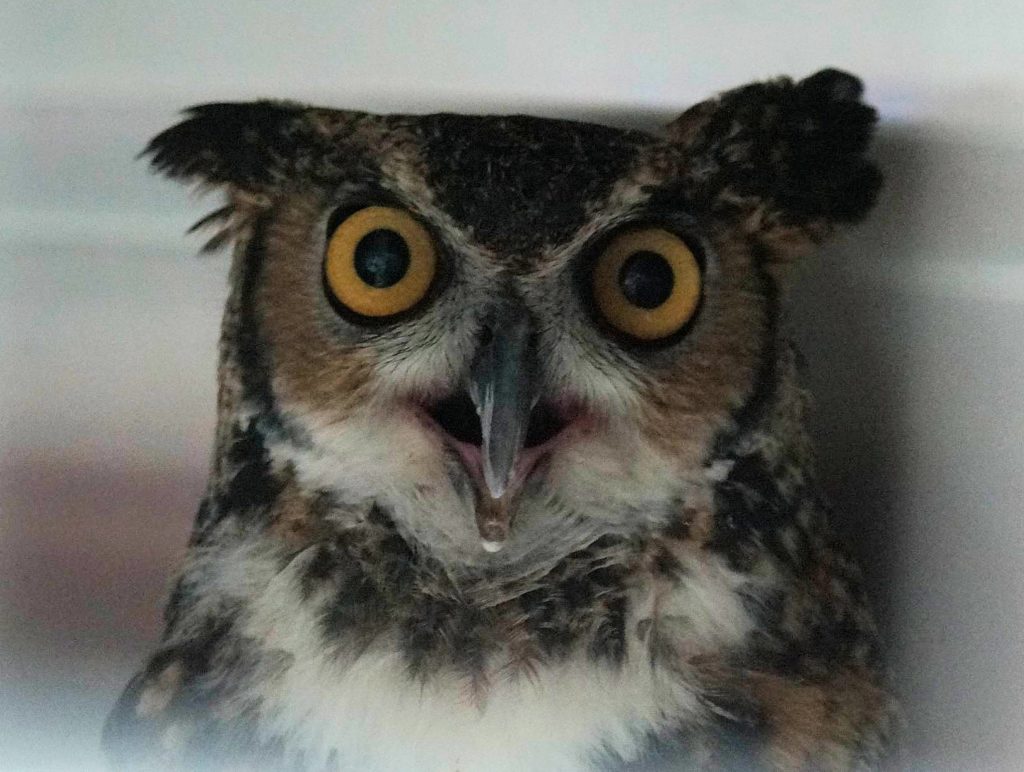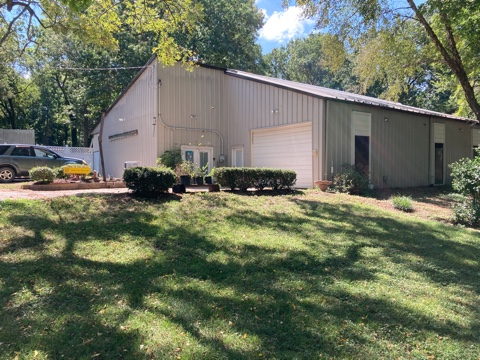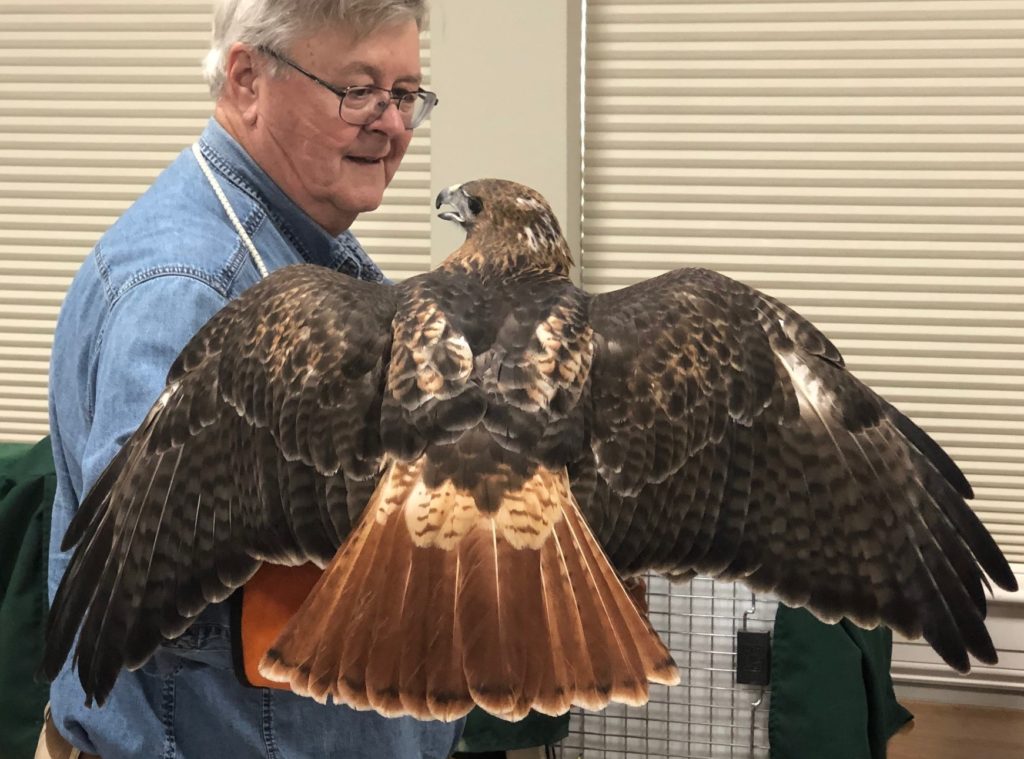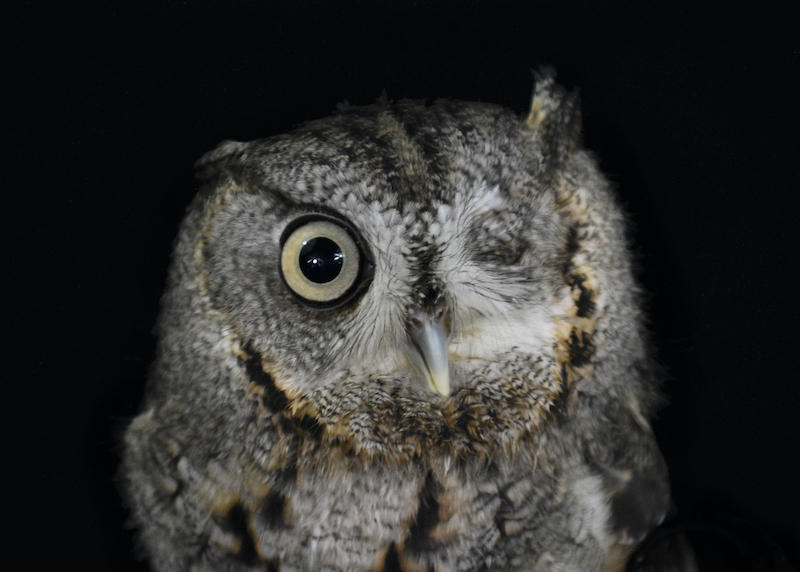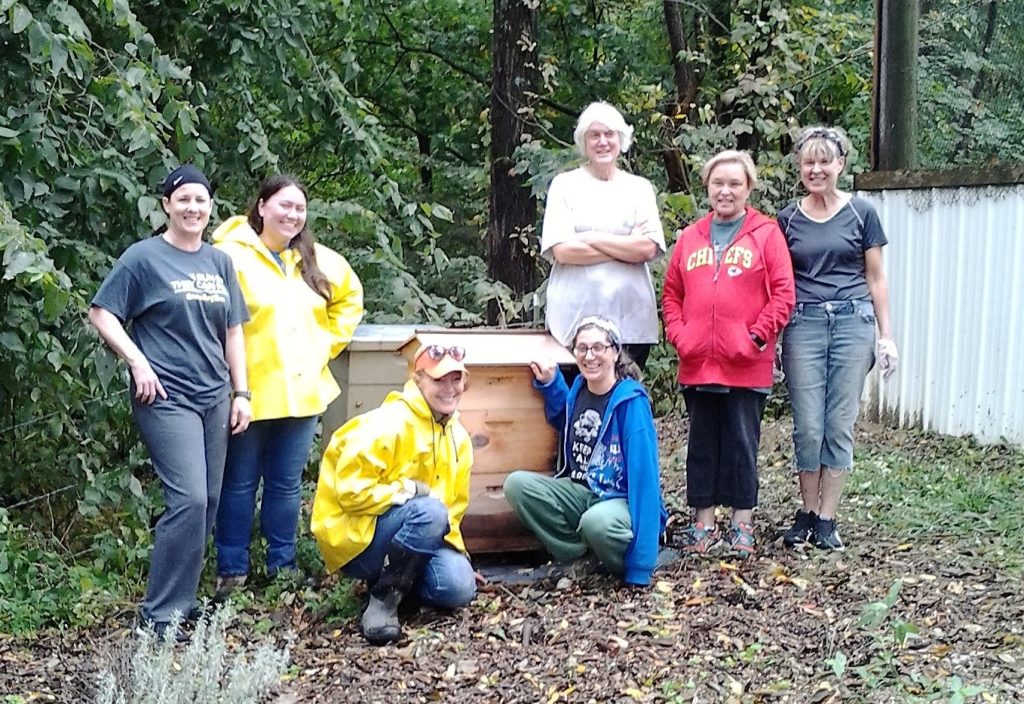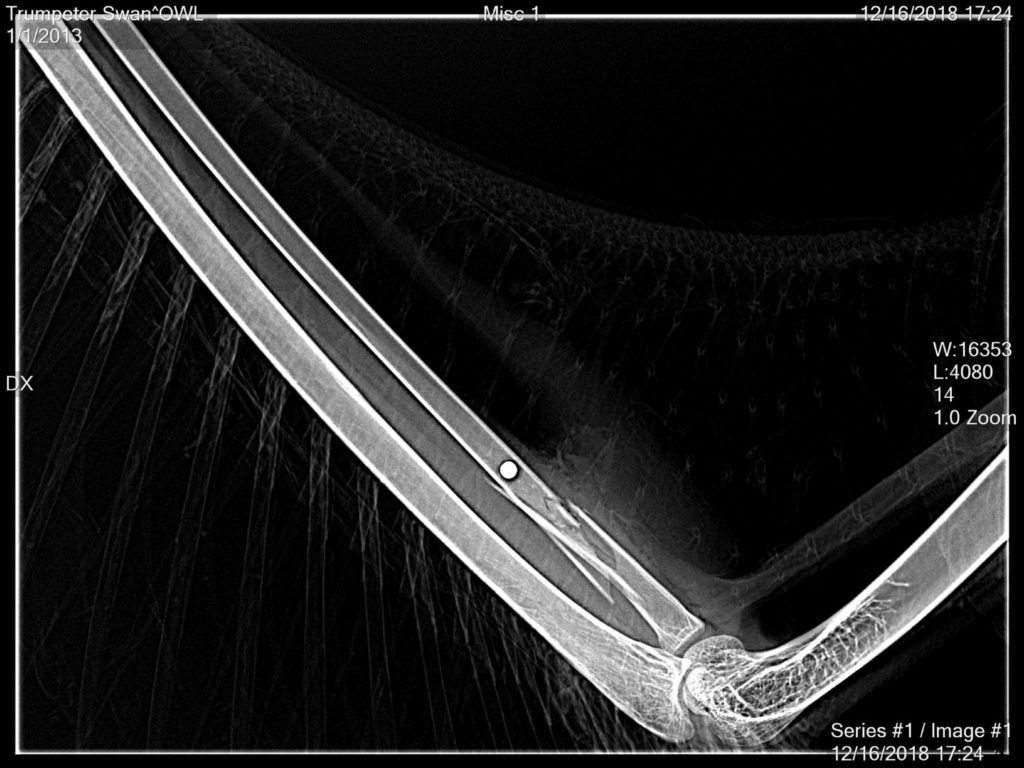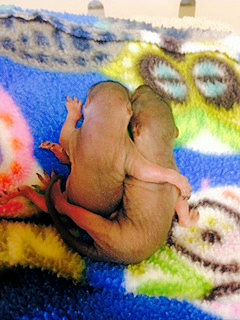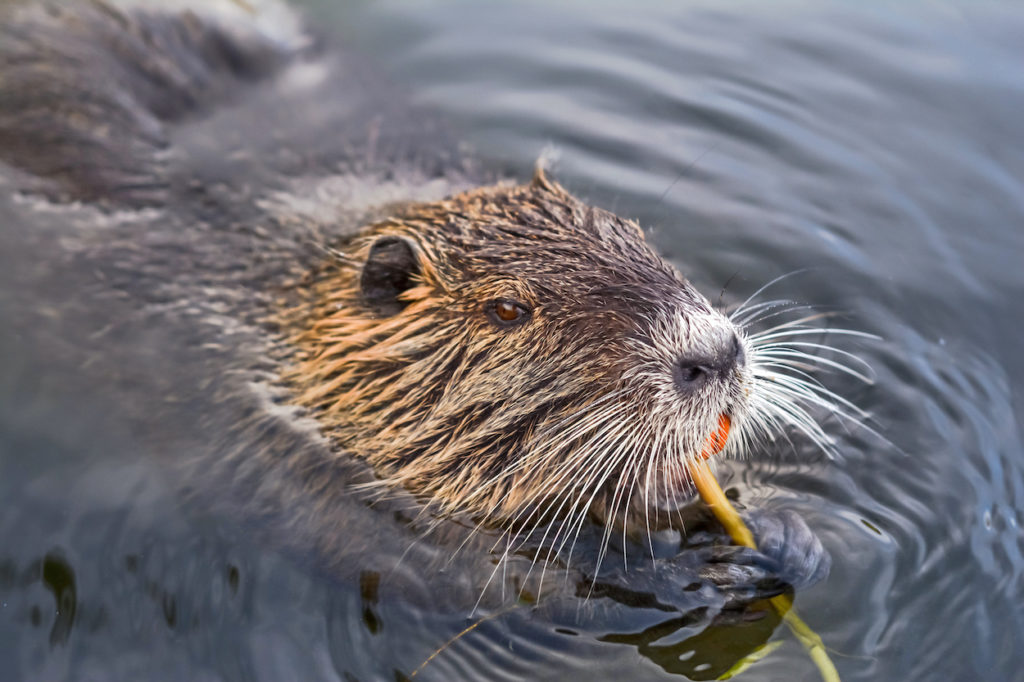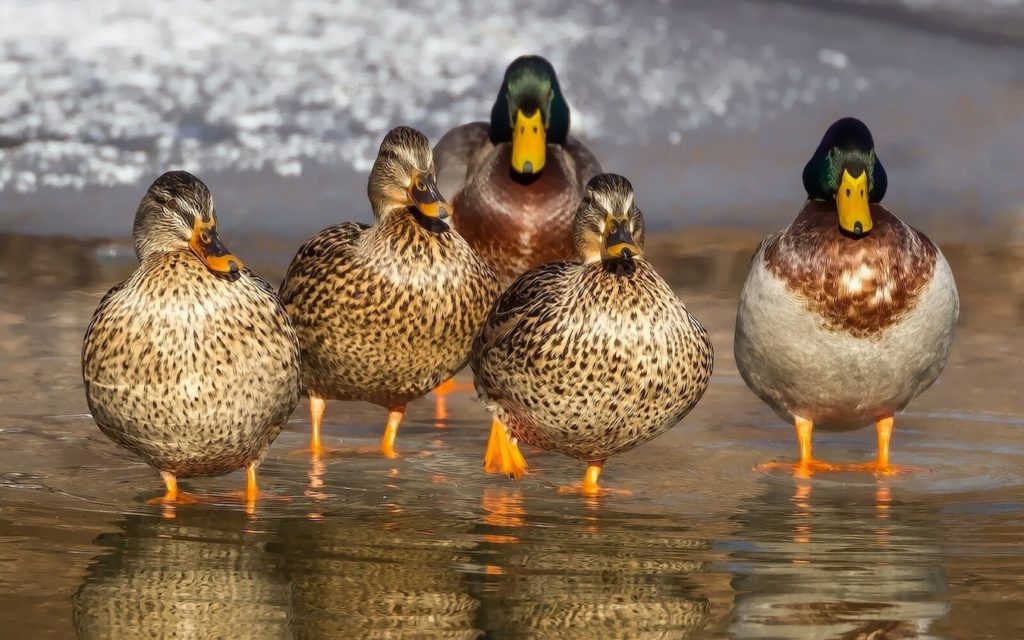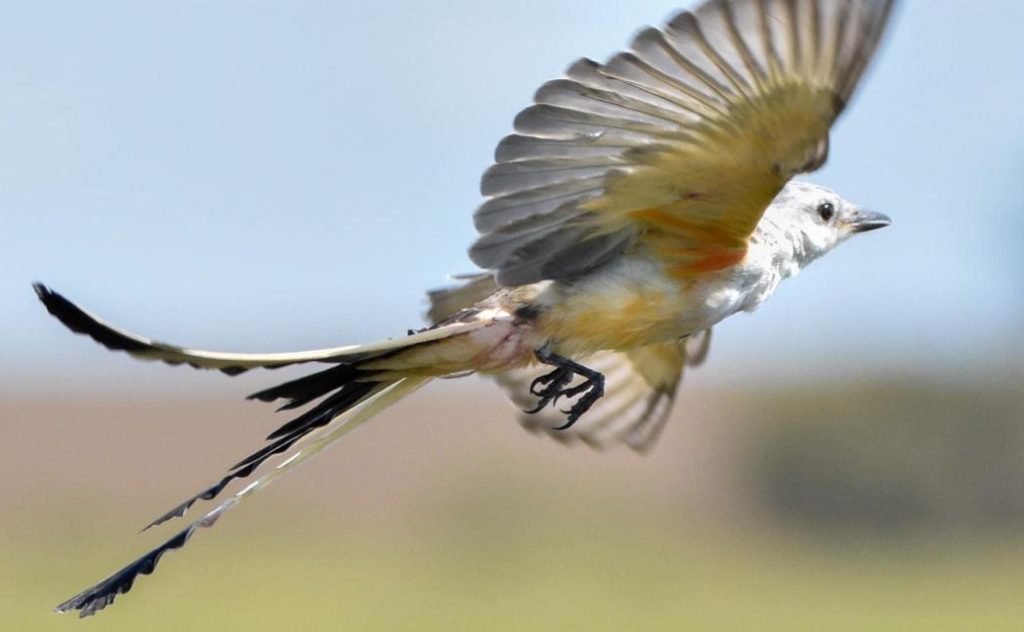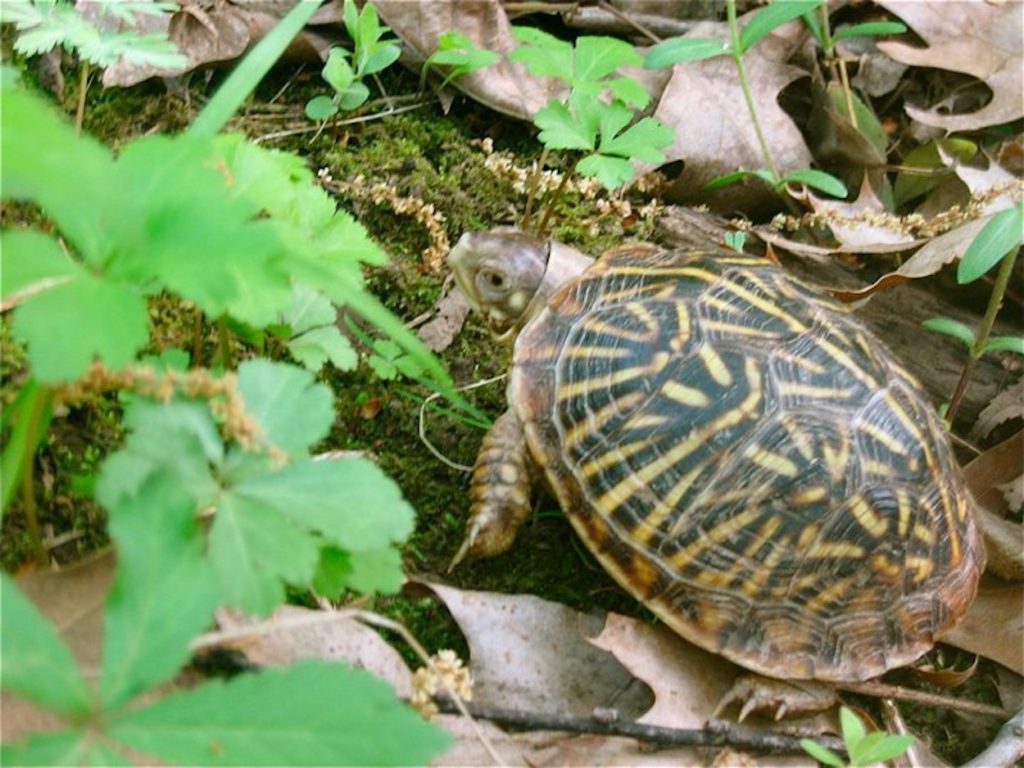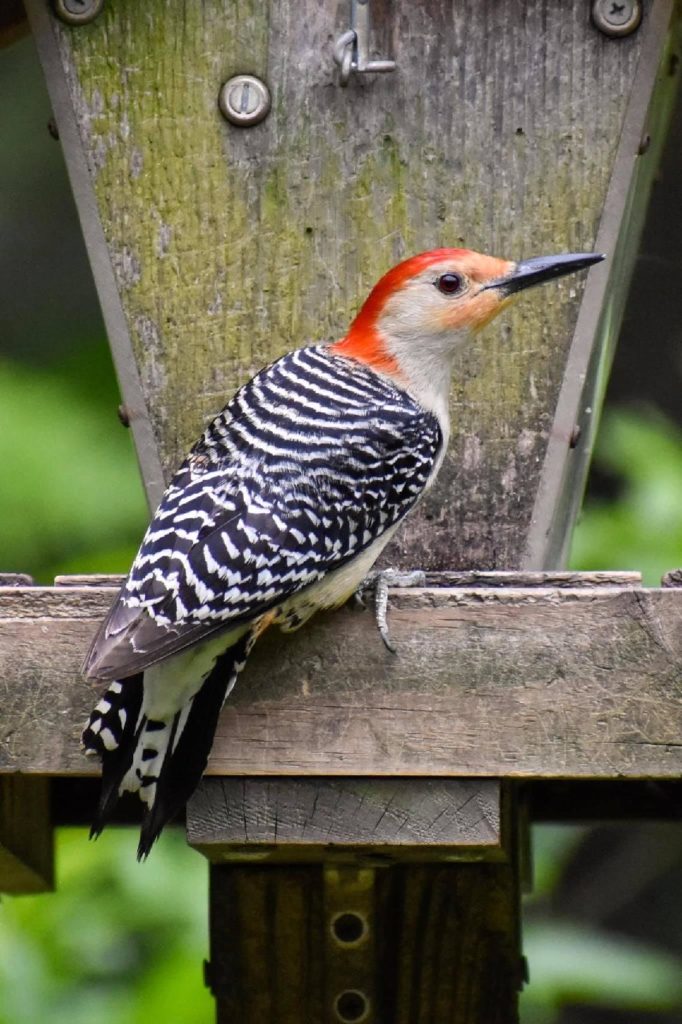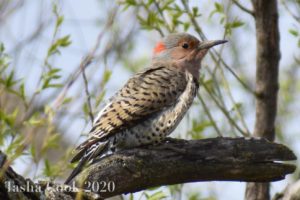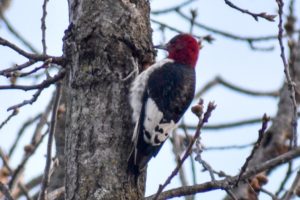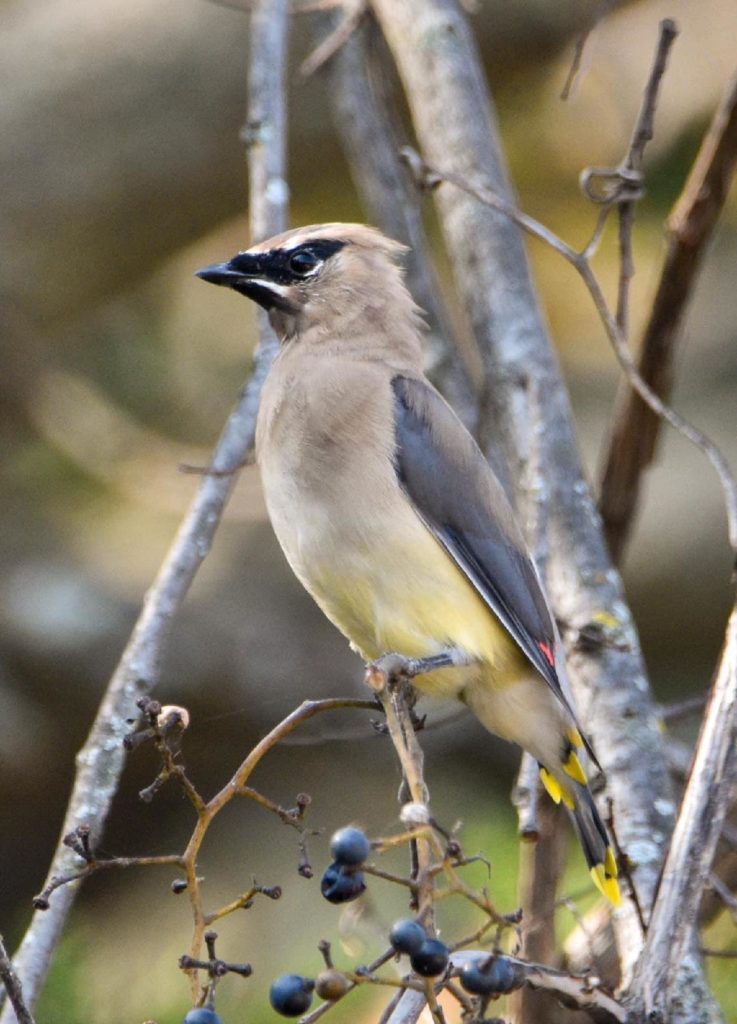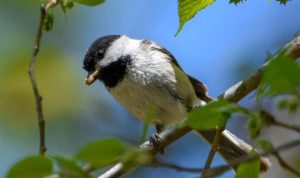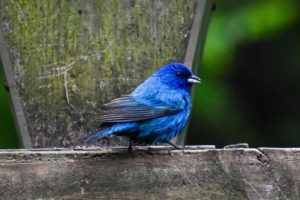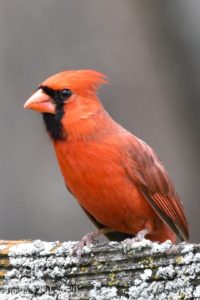About
Songbirds
All songbirds are protected by federal migratory bird laws. It is illegal to harm, remove, harass, destroy their nests and eggs, etc.
There are three exceptions to this law in the U.S. — European Starlings, English House Sparrows, and Pigeons. These are introduced species and do not have the same protection as other songbirds.
In the state of Kansas there are 208 recorded species of songbirds. Obviously, we can’t cover them all here but will focus on the most common injuries.
Baby songbirds – To rescue or not to rescue
If you find a baby songbird on the ground, you’ll need to know two things to determine whether the baby bird needs help. First, you need to know if the bird is injured and second, you’ll need to know if it is a nestling or fledgling.
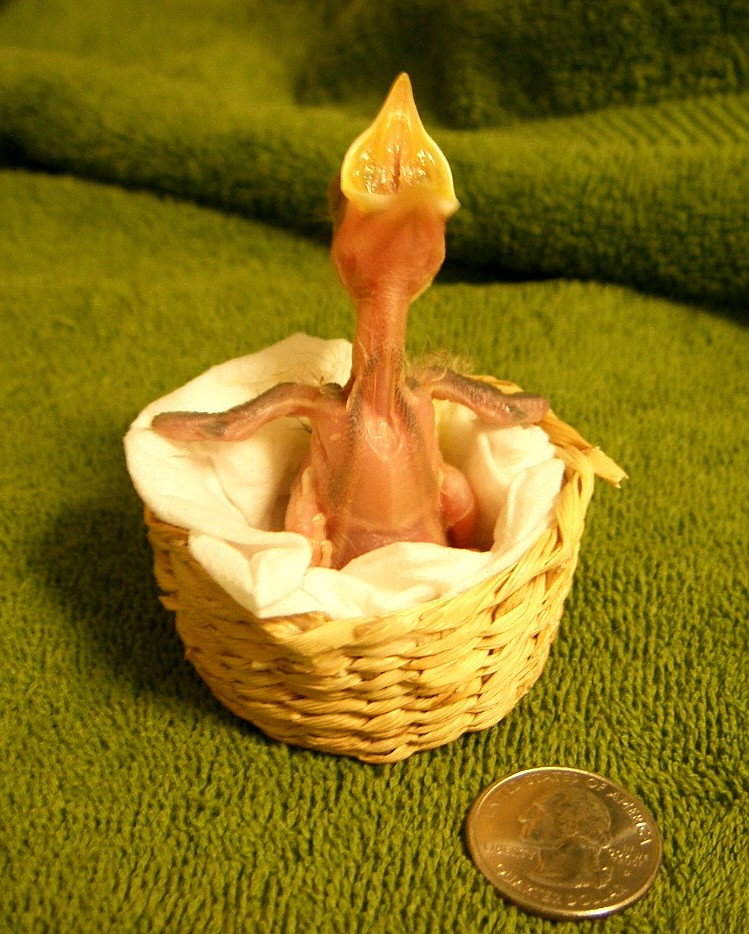
Hatchling
- No feathers
- See-through skin
- Bulbous body
- Frail appendages
- Unable to sit up
- Being fed by a parent
- Eyes shut
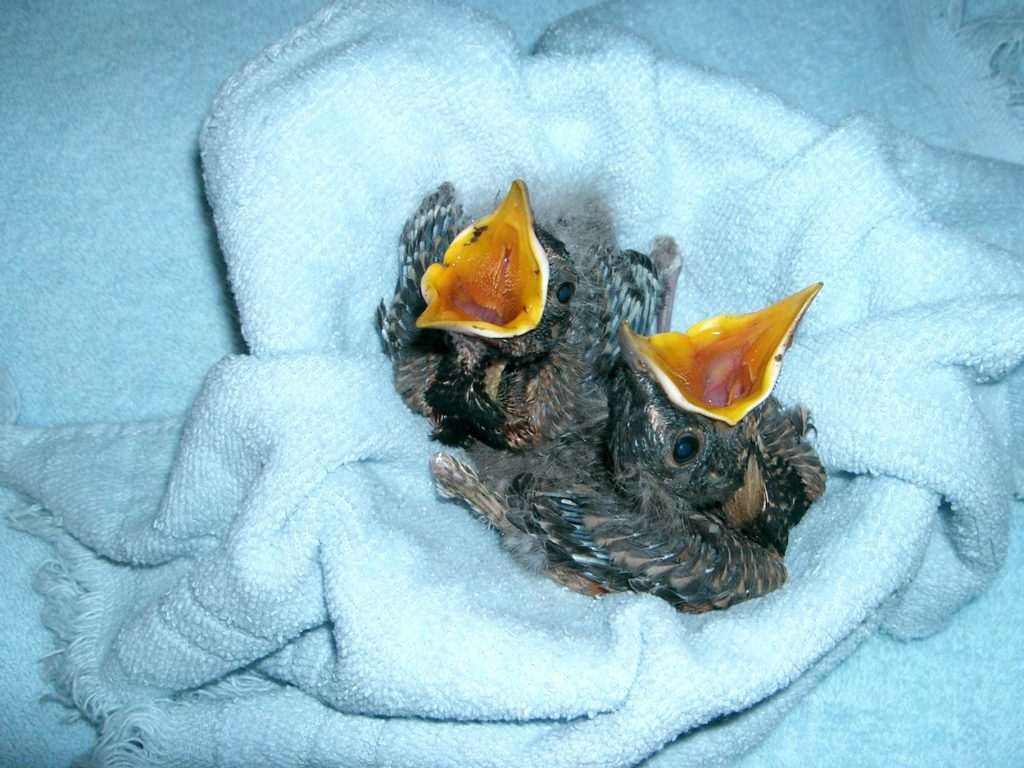
Nestling
- Quills show
- Feathers sprout
- Downy feathers
- Short feathers
- Pushes up on legs
- Being fed by a parent
- Eyes open
Nestlings – Out of the Nest
If the baby bird looks like a Hatchling or Nestling it is not old enough to be out of the nest. If the baby looks healthy but has fallen from the nest, put it back if possible. Songbirds don’t have a sense of smell, so it doesn’t matter if you touch it. IF you can’t reach the nest or the nest has fallen you can make a substitute nest.
Substitute nests can be made with a berry basket, margarine tub, or Cool Whip container. Poke holes in any plastic tub for drainage. If you have the actual nest, you can place it in the container. If you do not have the nest, line the container with dry paper towels in a softly curved bowl shape. Do NOT use green grass as it is wet and will chill the babies. The nest needs to be shallow as the parents sit on the side to feed the babies. Wire or nail the container as high up in the tree as you can and place it out of direct sunlight and protected from the weather. Then place the baby bird in its new nest.
The babies will chirp when they are hungry, and the parents should recognize and feed the babies. Watch at a distance for at least one hour to make sure the parents are feeding. If not, bring them to us as soon as possible.
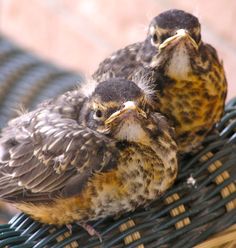
Fledgling
- Feathered
- Tail feathers
- Attempts flight
- Wing feathers
- Can balance
- being fed by a parent
- Gapes readily
Fledglings – A baby bird that is learning to fly
The only way for baby birds to learn to fly is to practice. When they have most of their feathers and a tail about a half-inch long, their desire to fly becomes overwhelming, and the young bird climbs to the edge of the nest and flies or flutters to the ground.
Birds at this stage can balance themselves, have eyes open, and usually flutter and hop around. The parents are keeping an eye on their offspring and are continuing to feed them every 30 minutes or so. You may not see the parents if you are near the baby because they recognize you as a predator and will avoid the baby so they don’t give it’s location away.
The parents swoop down and stick something in the baby’s mouth and then fly away to find new food. If the fledgling is in the middle of a busy road or sidewalk, move it gently over to the side under some bushes or another sheltered area. The parents will still hear its chirping and will continue to feed it. The parents may perceive you as a threat and might dive-bomb you, just as they would any predator that that approaches the baby. If the bird is in your yard, keep pets inside or on leashes for the next week until the baby learns to fly. Encourage your neighbors to do the same.
IF the fledgling eyes shows any Signs of Injury, call OWL. Do NOT attempt to give any food or water. Baby birds have an extremely high metabolism, so it needs to get professional help as soon as possible.
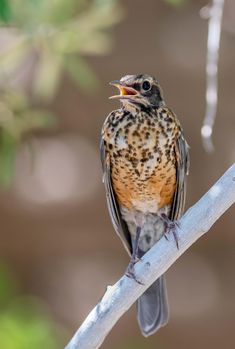
Brancher
- Feathered
- Normal imprint
- Defensive
- Able to fly
- Can perch
- Being fed by a parent
- Won’t gape for people
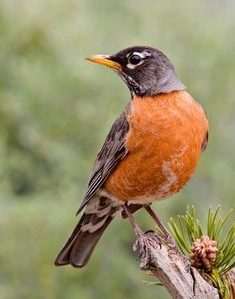
Adult
- Adult plumage
- Aggressive
- Adult size
Signs of Injury
If you notice any of these issues, contact OWL as soon as possible:
- Cold and lethargic.
- Makes no attempt to move, fly, open its mouth (gaping), or react when approached.
- Difficulty holding its head up.
- Covered with parasites—fleas, ticks, ants, or fly strike/eggs (looks like tiny grains of rice). (pic?)
- Dehydrated – run your finger up or down the skin on the bird’s breast. If the skin wrinkles and stays wrinkled, it is dehydrated.
- Has been in a cat or dog’s mouth, even if there are no visible wounds.
- Bleeding or has puncture wounds.
- Gasping or gurgling or making other noises when it tries to breathe. Birds will often scream and make noise when “rescued,” and that’s okay, but sticky sounding breathing, or gasping is not normal.
- Tilted to one side, falling over and not able to right itself, may be having seizures.
Common Concerns
Songbirds and their nests, eggs, and offspring are protected by federal law. It is illegal to move, destroy, or mess with an active nest. If the nest is inactive, with no signs of eggs, then it can be removed for disposal. Most songbirds nest for 36 days or less. Call us with specific circumstances and questions so we can help you find a solution that works for all involved.
These bug eaters nest in the rafters of barn, the awnings of businesses, ceilings of boat docks, and sometimes the rafters of your local Wal-Mart or Home Depot. Barn Swallows tend to be VERY protective of their nesting spot. When people walk near the nest, these birds swoop down and dive bomb the intruder. It SEEMS that they are going to hit you in the head, but they never do. They are only trying to chase you away from their nest. Do not swat at or hit them. Ignoring them is best. They will soon understand you’re not a threat and will leave you alone.
Chimney Swifts do live inside a chimney stack, usually a stone or brick chimney, and raise their young there. These flight feeders, meaning they feed in flight, are extremely beneficial. Two parents and their noisy offspring will consume more than 12,000 flying insect pests every day, including mosquitoes, gnats, termites, and biting flies. Chimney Swift numbers are declining due to loss of habitat — both large hollow trees and open masonry chimneys. Chimney Swifts make a nest of small twigs that are “glued” to the side of the chimney with a special substance made from their saliva. There is only one Swift nest per chimney. The babies are quite loud when being fed. Still, there will be only one active nest in any chimney at one time, although it may sound like more. Normally, by the time the babies become loud enough to hear, they are less than a couple of weeks from being able to feed themselves. After that, most of the loud noise will be over.
Chimney Swifts are protected by federal law under the Migratory Bird Treaty Act. Unfortunately, some chimney cleaning companies will still illegally remove active nests with young and discard them to die slowly in trash receptacles. When hiring a professional chimney cleaning company, be careful to select one that is reputable. Keep in mind that “bird removal” is a blatant violation of the state and federal laws that protect Chimney Swifts and other migratory birds.
Except for Swifts which have a special feather adaptation that allows them to “spike” the end of their tail into the chimney wall, birds cannot fly straight up. They must fly forward and up, making it impossible for them to escape a chimney once inside. Follow these steps:
- Move pets to a back bedroom or securely outside.
- Use a lightweight towel to catch the bird..
- SLOWLY open the flue of the chimney and close the screen or glass fire doors. You should hear the bird flutter to get out of the way of the flue.
- Once the flue is open, wait for the bird to drop into the fireplace.
- Cover it with the towel, and carefully turn the towel into a makeshift bag to wrap the bird.
- Do not squeeze or hold the bird too tightly.
- Take the bird, still wrapped in the towel, outside and release him back to the world.
Birds fly into windows on a regular basis. They hit windows because they evolved in a world without glass, and they simply don’t see them. What they do see is the reflection of sky and trees, and they unwittingly fly toward the mirage. Overcast skies may worsen the problem. Take these steps immediately.
- Place the bird in a paper bag or small box with a washrag in the bottom.
- Fold or tape the bag shut.
- Place the bag in a warm, dark, and quiet place for 60 minutes.
- After 60 minutes, take the bag outside, open, and wait. If the bird stays in the bag or cannot fly, bring to us – the bird likely has a concussion or other head injury.
Solutions
Many people report success with holographic or hawk-shaped window stickers or strips of foil hanging from eaves. A few long, one-inch wide strips of plastic garbage bags hanging in front of a window may provide a deterrent. So can a thin coat of artificial snow sprayed on the inside of a window.
Large expanses of plate glass can pose the biggest threat. Look at the feather imprints to determine where most of the collisions occur, then purchase a length of sheer nylon netting at a fabric store. Tack it with a thin strip of wood to the window frame, stretching it over the worst collision sites. You may also use black square mesh crop netting sold at garden stores. Neither will obstruct your view, and both will help prevent collisions.
You may also visit this website for other suggestions: https://www.worldbirds.org/how-to-stop-birds-from-flying-into-windows/
These are always male birds that don’t recognize their own reflections and think they are fighting another male bird to protect their breeding territory. Robins and cardinals are the usual suspects. This territorial behavior is evolutionary and hormonal, and the only solution is to remove the reflection. Once mating season is over this behavior will stop.
- Tape brown paper or something on the window to reduce the reflection.
- Install sun catchers to break up light waves.
- Tape an open garbage bag to the window.
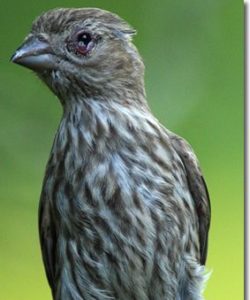
This is a fairly common infection that finch like birds acquire that is caused by a bacterium called Mycoplasma gallisepticum. The disease usually infects one eye first and then spreads to both causing blindness and starvation from an inability to see. The infection is spread by the birds wiping their faces on branches and bird feeders and then other birds coming in contact with the exudate. Birds that exhibit lethargy, fluffed out appearance or swollen face or eyes should be captured. Please place them in a small shoebox and call us. OWL can treat this disease and it has a recovery rate of 98% with treatment.
To Prevent the Spread of the Disease
- Clean feeders and bird baths on a regular basis with a 10 percent bleach solution.
- Avoid using moldy seed, and keep the ground area around the feeder as clean as possible. During the summer, rake the area to remove accumulated seeds beneath the feeder. During the winter, shovel fresh snow over the area.
- Use nonporous plastic, metal, or glass feeders that are easy to clean, and provide ample feeder space to reduce crowding.
- Keep platform feeders clean and put out only the amount of seed that birds can consume within a day or two.
Finally, don’t wait until sick birds are present to implement these precautions – routine cleaning is preventative.
The First Treatment for Shock or Injury: Warm, Dark, and Quiet
If you need to bring an animal into OWL, the most important thing you must do is to keep them warm and quiet. Baby birds can’t regulate their body temperature. Follow these directions.
Since a baby bird is too young to regulate its own body temperature, it needs to be kept warm. Put the baby in a box lined with a non-terry cloth towel. If you have a heating pad, turn it to the low setting and put in under one half of the box; if you do not have a heating pad, you can make something similar in two minutes.
Container
Line a butter bowl or dish with Kleenex, paper towels or toilet paper to make a concave soft nest. Put that in a shoebox or other small container with several small air holes in the lid and a small non-terrycloth towel, fleece cloth, or t-shirt in the bottom. Tape the lid to keep secure.
Heating Pad
If you have a heating pad, set to low and place the box half on/off the pad, so babies can move away from the heat if they need to. OR
Rice Bag
You can also fill a sock or knee-high pantyhose with uncooked dry rice. Microwave the rice-filled sock for 30 to 60 seconds. This heat source will last about 20 to 30 minutes. Place the rice sock in the container under the towel, and place the baby on or near it, but not directly in contact with the rice sock. OR
Ziploc bag
Fill a Ziploc bag with warm (not hot) water, put it inside another Ziploc bag, and place under the towel next to the bird. The double bag guards against leaks and prevents the animal from getting wet and chilled.
Food/Water
Do not attempt to feed or give them anything to drink. A birds trachea sits on the bottom of its mouth and they can be easily aspirated. Keeping the baby warm is more important than feeding it. We use a special formula that is made and measured specifically for wild birds.

Contact Operation WildLife for help.

